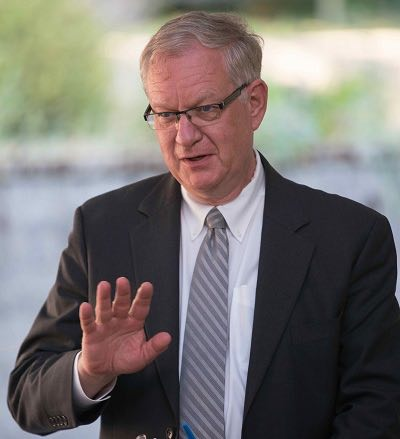
Photo: Daiwei Lu
By: Chris Trott
Modern scholarship in history has taught us that we not only have to critically examine documents from the past, we must also ask ‘What is being left out? What is being erased?’ The study of women’s history, for example, has shown that 51% of the world’s population has largely been left out of traditional historical narratives.
I first confronted such a historical absence on a pilgrimage I made with my friend Jaco Ishulutaq to Ummanarjuaq (Blacklead Island) in Cumberland Sound where the first Anglican mission to the Inuit on Baffin Island was established in 1894. When the mission closed in 1906, two local Inuit catechists, Tulugarjuaq and Killapik, were left in charge. Tulugarjuaq remained in Cumberland Sound and continued to teach and preach, while Killapik moved to Kimmirut (Lake Harbour) to help with the new mission there and later moved on to Salliq (Southampton Island).
When Jaco and I stopped at Qimmiqsuut, the site where Inuit had lived before and after the mission on Ummanarjuaq, we went to the remains of the house of Naullaq to reflect and pray. Jaco told me that Naullaq had been the catechist and had led the community in bible study and worship once the white missionaries had left.
Who was Naullaq? There is no reference to him in the missionary accounts of the region, although along with Jaco, other Inuit remember him, and there turns out to be one letter from him to Edmund Peck, the first Anglican missionary Inuit and founder of the Cumberland Sound mission, in the archives. For someone who clearly spent a very long time (from 1906 until at least the 1950s) as a catechist in Cumberland Sound and is dearly remembered by Inuit, why has he dropped out of the historical record? And why do we not hear of him as one of the core catechists who upheld the Gospel message when there were no missionaries?
I cannot answer that question, but it did alert me to the problem. As I began to expand my studies in the history of Anglican missions with Indigenous peoples in Canada, I kept asking myself the question, “Who are the other Naullaqs out there?” One of the great mysteries of mission history in Canada is why the Gospel spread so rapidly among certain groups of people and not among others. The answer has become clear: it was the work of forgotten and unnamed catechists, like Naullaq, that spread the word of the Gospel far beyond the reach of the non-Indigenous missionaries.
According to the official Native Church Policy of the Church Missionary Society (CMS), the intention of their work was to raise up local churches and local clergy among Indigenous people to take over the preaching of the Word so that the non-Indigenous missionaries/clergy could move on to new fields of work. The policy never really seemed to work, and the CMS continually complained that their missionaries seemed to get “stuck” in certain missions. The problem was that the mission society was being compared to the English parish church led by ordained clergy. If that is the model, then, indeed, the policy was a failure.
In the nineteenth-century history of our ecclesiastical province and diocese, the names of ordained Indigenous clergy are fairly well known: Henry Budd, James Settee, Robert McDonald, and Edward Ahenakew. Some, like Thomas Vincent are known for feats like walking all the way from Fort Albany to the Red River Settlement to get ordained!
Then we get into the hazier ground of catechists, defined in Roman Catholic Canon Law as: “lay members of the Christian faithful, duly instructed and outstanding in Christian life, who devote themselves to setting forth the teaching of the Gospel and organizing liturgies and works of charity under the direction of a missionary.” Some may have heard of Charles Pratt, who served in the Qu’Appelle Valley because of the writings of his historian and descendant Winona Stevenson. But what of Henry Turner, who worked with James Settee, or John Hope, who worked in Battleford, Saskatchewan? Most Indigenous Anglican communities are still led by catechists, but do we know who they are, and do we pray for them regularly in our cycles of prayer?
Even less well-known are teachers like Joseph Cook, who taught with Rev. Cochrane in the 1840s at Cook Creek, or James Vincent, who taught school at Fort Albany. My favourites, of course, are those laypeople who usually took a few courses at St John’s College and then went on to preach the Gospel while they worked for the Hudson’s Bay Company. These include Gary Spogan, James Hope, Kenneth McDonald, and John Umpherville.
Since I have started looking into Indigenous Anglicans who preached the Gospel in the nineteenth century, I have compiled a list of 29 men. Every time I speak to this subject, or write a column like this, I add more names and memories.
It does not take a sharp eye to notice that there are no women on this list. I am sure that there were as many women teaching and preaching the Gospel on a day-to-day basis as there were men, but they have been erased completely from historical memory.
What does bringing to light these erasures tell the modern church? Not just that those who are officially sanctioned by the church are called to spread the Gospel, but all faithful Christians do so. And, if the history of Rupert’s Land in the nineteenth-century is anything to go by, they are very good at doing this work, reaching into corners of the world where the church otherwise might not go.
Christopher Trott has now retired as Warden of St John’s College and as Associate Professor in Indigenous Studies at the University of Manitoba. He is now a volunteer at the Assiniboine Park Zoo and continues to teach one course a term at the University.






